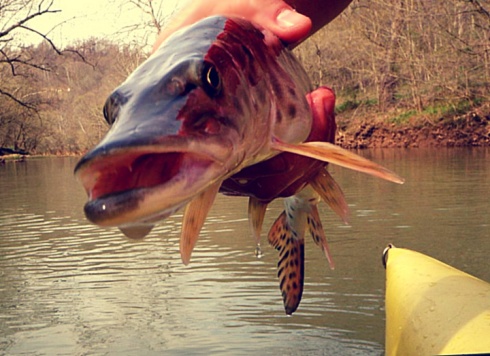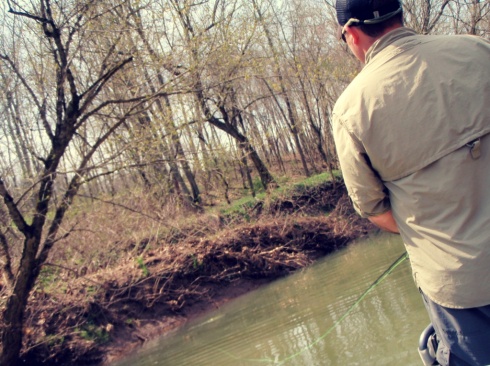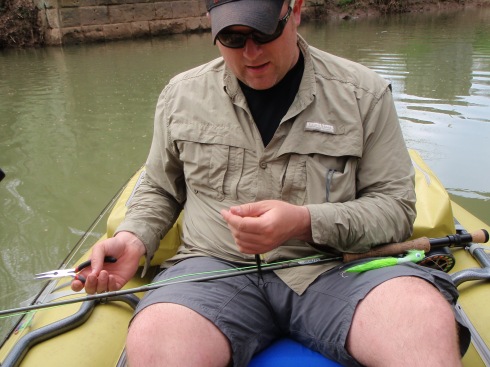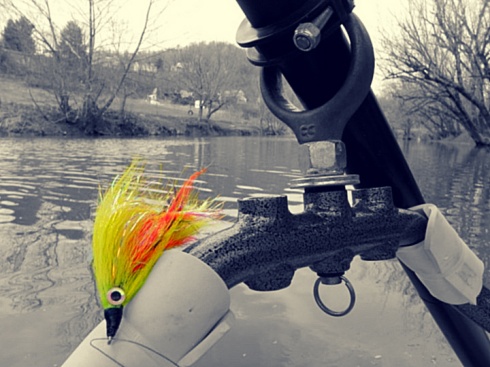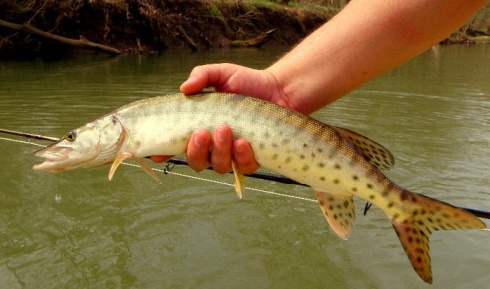Last year I vowed to land the elusive fish of 10,000 casts (more like 16,743 and counting with a fly rod). But after a few futile attempts by myself I deemed it impossible. So with the new year comes another vow towards the same quest, this time with new friends with the same goal. Here is some of the reading that I’ve come across on the 101’s of muskie fishing with a fly. I’ll let you know which fly I prefer as soon as I catch one….or if I ever catch one. I’m pretty sure I saw a show on the outdoor channel where a guy casted a rubber chicken rigged with some hooks.
IN THE VAST WORLD of fishing, fly fishing for muskie is definitely considered out on the edge. Known for their often massive size, violent head-shaking strikes and razor-sharp canines, muskies are not for the faint of heart. This is one species you don’t want to get too close to without the proper equipment. In fact, in the old days muskie fisherman actually used to shoot their fish in the water before ever bringing them in the boat. On the other hand, if you enjoy casting big 2/0 flies all day just for a chance to see a huge fish grab your offering — often right at your feet — then this might just be the sport for you.
For those not familiar with the muskie, it looks and behaves like a cross between a northern pike and a barracuda, only — at least in the estimation of muskie devotees — it’s stronger and tougher. While most muskie caught today are in the 30- to 40-inch range and 10 to 20 pounds, giant fish up to 50 inches and over 40 pounds are still caught every year. The Wisconsin-caught “official” all-tackle world record still stands at an unbelievable 69 pounds and 11 ounces.
Even non-fly anglers know the muskie as the “fish of 10,000 casts.” That’s because the muskie sits at the very top of the predator pyramid in any waters it inhabits. As such, it has its pick of anything it wants to eat including smaller game fish, birds, mammals, and the occasional dangling toe (bright red nail polish preferred). With so much to choose from, muskie also have an annoying habit of “following” a fly but not striking — a bit like a false rise from a trout or salmon.
As the undisputed king of freshwater predators, the muskie is also the subject of many a fish tale, real and imagined. Hang around muskie fishermen long enough and you’re likely to hear all kinds of stories about honey holes crowded with hungry giant muskies. The truth of the matter is that these are tough fish to catch on any kind of gear and if anyone says they can catch muskies with ease my advice is to walk away before they try to sell you some ocean front property in Wisconsin.
Once you’ve mastered the mind game of muskie fishing you’ll need the proper gear. An 8½- to 9-foot, 9-, 10- or 11-weight graphite fly rod with some serious backbone is a good start. Graphite rods are perfect for this fishing as there light enough to cast all day and have good hook-setting abilities. Most saltwater graphite rods from the major manufactures are fine for this kind of fishing.
The reel is not as critical a component for muskie fishing as for most saltwater species, however, as a muskie will not normally make a blistering run like a bonefish or tarpon. But they do fight hard when hooked, making alligator-like twists and turns and short but powerful lunges, particularly at the boat. I’ve fought many a muskie by stripping them in by hand but always try to get them on the reel. Good drag systems make life a whole lot easier.
As for fly lines, you’ll need a heavy line weight just to carry the big flies, especially if it’s at all windy. I fish both weight-forward floating and sink-tip lines in from 9- to 11-weight sizes depending on the conditions. I also like to use my own shooting heads whenever possible to reduce casting time and wear and tear on the arm. When choosing a line look for something with a hard finish and bass bug or “Big Fly” type taper that will cast and shoot well all day.
Leaders for this fishing are not complicated but remain the critical link between you and your fly. Muskie are not known for being “leader shy,” so I like a short 6- to 9-foot hard mono leader tapered to a 15- to 20-pound tippet. You can use a lighter leader but given the size of the flies you’ll find it hard to turn them over. If you’re new to this sport and still looking for your first muskie, go as heavy as is comfortable and increase the odds of landing your fish.
As you might imagine, there’s also no getting around some kind of direct wire connection to your fly with these fish. Fortunately several manufactures now make tie-able wire for just such a purpose. Tyger Wire is a good example. I like to use at least 12 to 15 inches of wire bite tippet. (For the record, I once had a very nice muskie take my fly head on and swallow the entire rig up, including the leader, up to the nail knot on my fly line!)
Muskie flies run the gamut from streamers to poppers, with a common theme of large and light. By large I mean 8 to 15 inches in length, sometimes even larger. Remember, the hardware-throwing guys sometimes use lures as big as toaster, so you just can’t go too big! This is not to say muskie won’t take a smaller fly; it’s just that with the difficulty of getting this species’ attention and the lack of any serious water-pushing action, as can be achieved with a popper, you’ll need a big profile to attract big fish. With the advent of modern synthetics and hairs this task has become a lot easier for the fly tier. You can find some decent patterns in the saltwater section of your local fly shop bin or favorite catalog. But since bigger is almost always better and muskie are not finicky about neatness, you may find tying your own flies is a good option.
As for colors, “match the hatch” whenever possible and use a predominance of black, white, yellow, and greens, including chartreuse. These colors imitate the primary forage in most muskie waters: perch, walleye, suckers, and ciscoes. When fishing dark or stained water, opt for the brighter colors, and tone it down in clear water. If you have to pick one color that produces day in and out, white is probably the best performer.
The approach and techniques for fly fishing for muskie are as varied as the water you’ll fish and, frankly, would take more than a single article to explore. There are, however, some important behavior patterns that should help to get you started. In the spring season after the spawn and the fishing opener (May to June depending on the state) muskies tend to hang in shallower and warmer water much like their often smaller cousins the northern pike. This means focusing on shallow bays, creek mouths, and emerging weeds. Once summer starts to take hold I like to spend my time in both shallow and more open water, especially areas where you’ve got isolated structure such as rock bars or weed beds. When the water starts to cool again in the fall I move back to shallower structure paying special attention to steep breaks close to shore.
It’s also important to note that whatever season you fish you’ll increase your odds if you cover as many different types of structure as possible with the fly. The first fish you see or catch will tell you a lot about the pattern for that day. While I’ve caught muskie on a fly every month of the fishing season, it’s been my experience that spring and early fall are generally best due to the higher metabolism and aggressive nature of these fish in warmer water.
It should also go without saying that when you finally do catch your first muskie on a fly, you should release it carefully, just as you would a wild trout or steelhead. This practice along with longer minimum legal limits on many lakes and rivers has led to a pronounced increase in the quality of muskie fishing throughout the US and Canada.
Finally, though nothing can take the place of time on the water, here a few more tips that apply whenever and wherever you fish for muskie:
- Cover the water: Not easy to do with a big rod and wind-resistant fly but it’s the only way to find your first fish.
- Change flies: If you’re not getting any action don’t hesitate to change flies. This means going from large to small, top-water to streamer, and bright vs. dark.
- Change your retrieve: If you’re not getting any strikes or follows, try picking up the speed — you can’t move the fly fast enough with a hand strip for a muskie!
- Change your depth: Depending on the season and water you might find muskies in 6 inches of water or down 20 feet or more.
- Always watch your fly: As noted above, muskies love to follow a fly and will often strike at the end of your retrieve (even when you’d swear there’s nothing following).
Article by Roberty Tomes at Midcurrent.
MORE TIPS
Rods, Reels and Lines
Most serious musky fishermen use an 8 1/2 to 9 foot, 9-, 10- or 11-weight graphite fly rod. Any large arbor reel with a good drag system will suffice. A heavy weight-forward fly line will quickly load the rod and turn over bulky flies. This allows for less false casting and quick followup casts. Consider a heavy sink tip or shooting head when fishing deep water. Fly lines designed for saltwater species often work well for musky fishing and are available from most manufacturers.
Muskie Flies
It takes a big fly to get the attention of a muskie. Most muskie flies are 8 to 12 inches long with some topping 15 inches. Streamers and top water flies are both effective. Saltwater poppers and large divers create commotion on the surface and elicit violent strikes. The best color choice is a subject of much debate. Experiment with different color combinations and don’t be afraid to change flies. White, black, orange, and chartreuse are all popular musky colors. The mouth of a musky is tough and bony, so make sure your flies are tied on razor-sharp hooks.
Leaders and Bite Guards
Muskies are not known to be shy, so long leaders are not necessary. A 4- to 6-foot tapered leader is adequate. Longer leaders will increase the odds of fooling trophy bass and pike that may chase your offering. Regardless of leader length, a bite guard is essential. There are several brands of knotable wire that will stand up to the razor sharp teeth of a muskie. Heavy monofilament in the 60- to 80-pound class will also prevent biteoffs. Muskies will often inhale a fly, so make sure your bite guard is at least a foot long.
Casting and Retrieving
Keep your casts short–40 to 50 feet is sufficient. This will improve your hook setting ability and help you spot fish that may be following behind the fly. Vary the speed of your retrieve. Muskies are attracted to fast sudden movements, so don’t be afraid of moving the fly too fast. Never stop or slow down the fly if a muskie is following. This is unnatural and often results in a lost opportunity. If a fish follows the fly but turns off it, quickly cast again in the same area. Consider rigging a second rod with a different fly to use on followup casts.
Catch and Release
After landing a muskie, carefully remove the hook and snap a quick picture before returning your trophy to the water. Adequately revive the fish before releasing it to fight another day. Practicing catch and release helps ensure good fishing for generations to come.
Tags: 10000 casts my ass, I just lost 30$ worth of fly tying material, I used everything in my fly tying kit to make this one fly, My arm hurts

